In the reporting year, ORR successfully challenged National Highways on its ability to deliver no net loss in biodiversity and reduce its corporate carbon emissions by 2025. The company produced robust plans following the concerns we raised. We will continue to hold National Highways to account to deliver its end of road period targets. In particular, we will scrutinise and evaluate the company’s plans to deliver biodiversity improvements and corporate carbon reductions.
4.1 National Highways has a key performance indicator (KPI) target for the second road period (RP2) to deliver no net loss of biodiversity by 2025. In our last annual assessment, we reported that the company was forecasting a biodiversity net loss by 2025. As a result of ORR’s challenge and increased engagement, the company produced a robust biodiversity delivery plan in September 2022. It is now forecasting that it will achieve no net loss of biodiversity by the end of RP2.
4.2 In the reporting year, government agreed to adjust National Highways’ RP2 corporate carbon reduction KPI target. This was because grid electricity production is more carbon intensive than was forecast in 2020 when the target was set. The company remains committed to reducing its electricity usage by 22% by the end of RP2 compared to the baseline as originally planned.
4.3 National Highways has plans in place that it believes will meet its second road investment strategy performance commitments on air quality and noise. We continue to scrutinise the company’s environmental plans to satisfy ourselves that they are robust, deliverable and will enable it to meet its performance targets.
Outcome: Being environmentally responsible
4.4 National Highways has four targeted KPIs, four performance indicators (PIs) and two commitments in this outcome area.
KPI: biodiversity
4.5 National Highways’ target is to deliver no net loss in biodiversity by the end of RP2. At the end of March 2023, the company forecast a net gain of 2,025 biodiversity units for the end of the road period. This only includes funded projects with a high confidence of delivery in the next two years.
4.6 A biodiversity unit is linked to the size, condition and location of a habitat or piece of land (see Natural England’s website). In 2020, National Highways calculated a baseline of 130,848 units across its estate. This covers all the company’s land, including verges either side of the carriageway. The company then estimated the biodiversity loss from all enhancement schemes planned to start work in RP2, alongside a 1% degradation each year. This degradation accounts for loss from day-to-day renewals and maintenance activities and the operation of the network, such as noise and air pollution.
4.7 National Highways estimated that without any additional biodiversity mitigation there would be a loss of 4,166 biodiversity units over RP2.
4.8 Last year, ORR challenged National Highways to produce an updated plan to demonstrate how it would achieve no net loss by the end of the road period. We received and scrutinised the plan to satisfy ourselves of its robustness. We have also worked with the company to increase our engagement on this area and it now shares quarterly detailed updates on its pipeline of biodiversity improvements. The company has funded projects expected to deliver up to 4,069 biodiversity units. This would deliver a net gain of 2,025 biodiversity units over RP2. It also has further schemes in design and feasibility that could deliver an additional 3,597 biodiversity units.
4.9 In the reporting year, National Highways delivered 1,618 biodiversity units. Figure 4.1 shows that since April 2020, the company has delivered a total of 2,122 biodiversity units.
Figure 4.1: National Highways’ biodiversity programme at April 2023 (excluding schemes in early design)
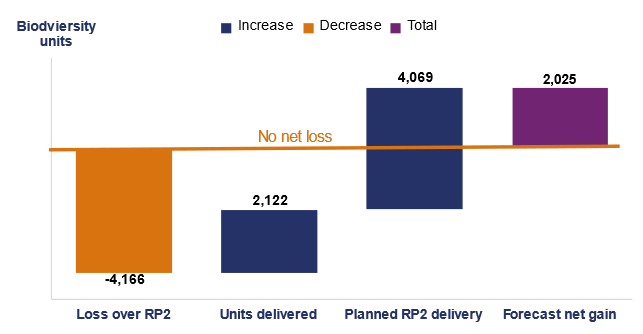
Case study: Biodiversity – M60 wildflowers
National Highways has a key performance indicator (KPI) target to achieve no net loss of biodiversity by 2025. To support delivery of this, the company:
- designs its enhancements to minimise loss of biodiversity;
- considers on-site biodiversity improvements that it can deliver alongside its enhancements; and
- funds biodiversity improvements using the environment and wellbeing designated fund.
In March 2023 National Highways delivered a wildflower scheme near Ashton-under-Lyne, alongside the M60 near Junction 23. The company carried out surveys of the three-hectare habitat to establish a baseline. It then undertook works to improve it, using robotic mowers and scarifiers to prepare the ground and remove cut grass and planting specially selected lowland meadow seeds to introduce biodiversity.
National Highways will monitor the site for at least five years. For each of these years the company will do a full cut and remove the cuttings to encourage wildflower growth and establishment.
The scheme had a budget of £427,000, funded by the environment and wellbeing designated fund. This scheme delivered 23 biodiversity units towards the company’s biodiversity KPI.
National Highways will deliver a similar scheme to introduce species-rich grassland on the M6 in Cumbria as part of its Network for Nature programme.
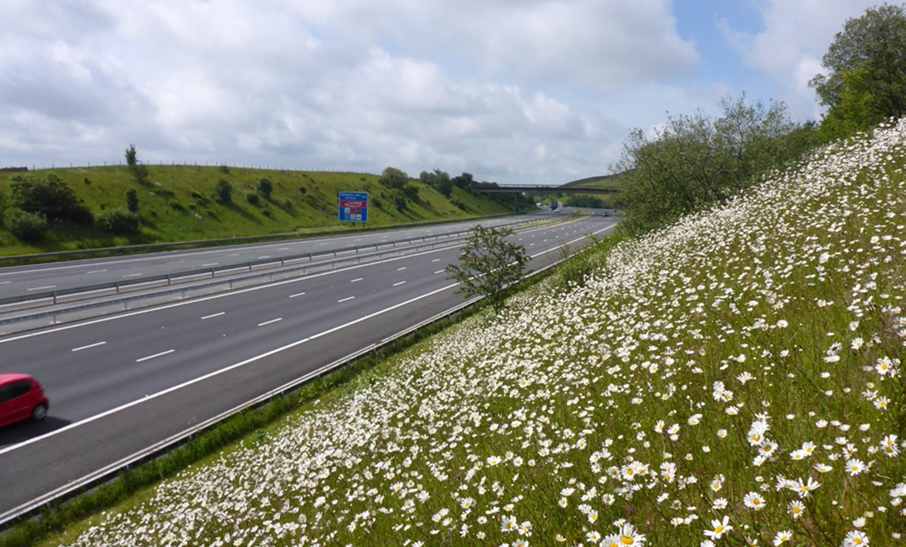
Source: National Highways, wildflower planting alongside the M60
KPI: corporate carbon
4.10 When the RP2 performance specification was set, National Highways had a KPI target to reduce its corporate carbon emissions by 75% by 2025 compared to its April 2017 to March 2018 baseline.
4.11 In the reporting year, government agreed to adjust National Highways’ RP2 corporate carbon reduction KPI target. This proposal has changed the target from a 75% to a 67% reduction by 2025 compared to the 2017 to 2018 baseline. This was due to the carbon intensity of generated electricity being higher than modelled in 2020, when the original target was set. National Highways’ longer term ambition for net zero corporate emissions by 2030 is unaffected by this change.
4.12 The revised target does not affect the actions National Highways is taking to reduce its corporate carbon emissions. For example, the company is still committed to reducing its electricity usage by 22% by 2025. This is the source of over half of its carbon emissions. Given this, in addition to corporate carbon emissions, we will also analyse and report on the company’s electricity usage for the remainder of the road period.
4.13 Figure 4.2 shows that National Highways emitted 44,809 tonnes of carbon dioxide (CO2) in the reporting year. This was a 50% reduction compared to its April 2017 to March 2018 baseline but 1,910 tonnes higher than the company projected.
Figure 4.2: National Highways’ corporate carbon emissions, April 2017 to March 2018 baseline and April 2021 to March 2023
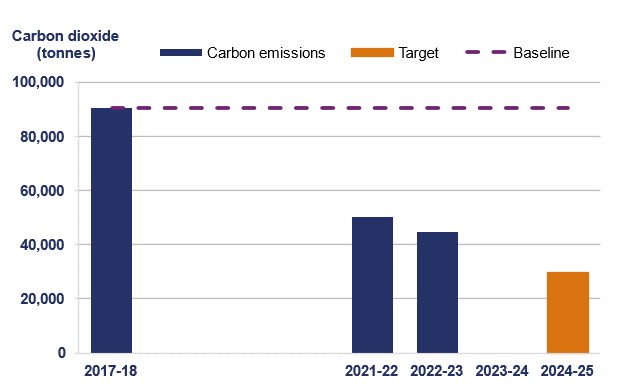
4.14 National Highways’ performance in the reporting year was worse than it expected due to slower delivery of new hybrid operational vehicles. The company has plans in place to deliver its 2025 target by installing LED streetlights (discussed in our case study), rolling out more hybrid and electric vehicles across its fleet and reducing energy use in its offices and buildings.
4.15 Figure 4.3 shows that National Highways used 184 gigawatt hours (GWh) of electricity in the reporting year. This was 4GWh less than the previous reporting year and a 13% reduction on the baseline.
Figure 4.3: National Highways’ electricity use, April 2017 to March 2018 baseline and April 2021 to March 2023
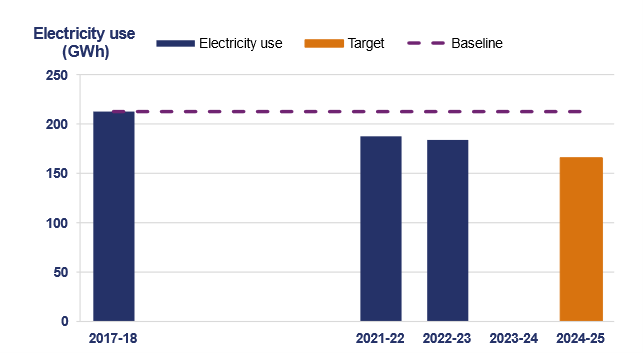
Case study: LED roll-out
National Highways has a target to reduce corporate carbon emissions from its estate and day-to-day operations to net zero by 2030. This is an ambitious target.
The largest contributor to National Highways’ corporate carbon emissions is the electricity it uses to light and operate the strategic road network (SRN). Corporate carbon emissions also include vehicle fuel for traffic officers’ vehicles, business travel, corporate purchases, and waste.
Electricity in the UK grid is produced by a mixture of renewable energy sources (wind, solar) and fossil fuel-based generation (coal, gas, oil). National Highways has little control over the source of grid electricity it uses or how this changes from year to year. More than half of the company’s electricity use is to light the SRN, so by installing LED bulbs that consume far less electricity than standard lightbulbs the company can substantially reduce its electricity usage and corporate carbon emissions.
National Highways estimates that it has 105,000 streetlights on its network. By February 2023, it had converted 26% of its streetlights to LED, so there is an opportunity for large electricity reductions. On average, LED bulbs save 437kWh per year compared to conventional bulbs. The company plans to install 32,000 LED bulbs across its network by the end of the second road period. It expects that the LED programme would save 13GWh of electricity by 2025.
National Highways has agreed to supply ORR with quarterly updates on its electricity usage and its delivery of LED streetlights. We will use this information as part of our work in holding the company to account to reduce its corporate carbon emissions by 2025.
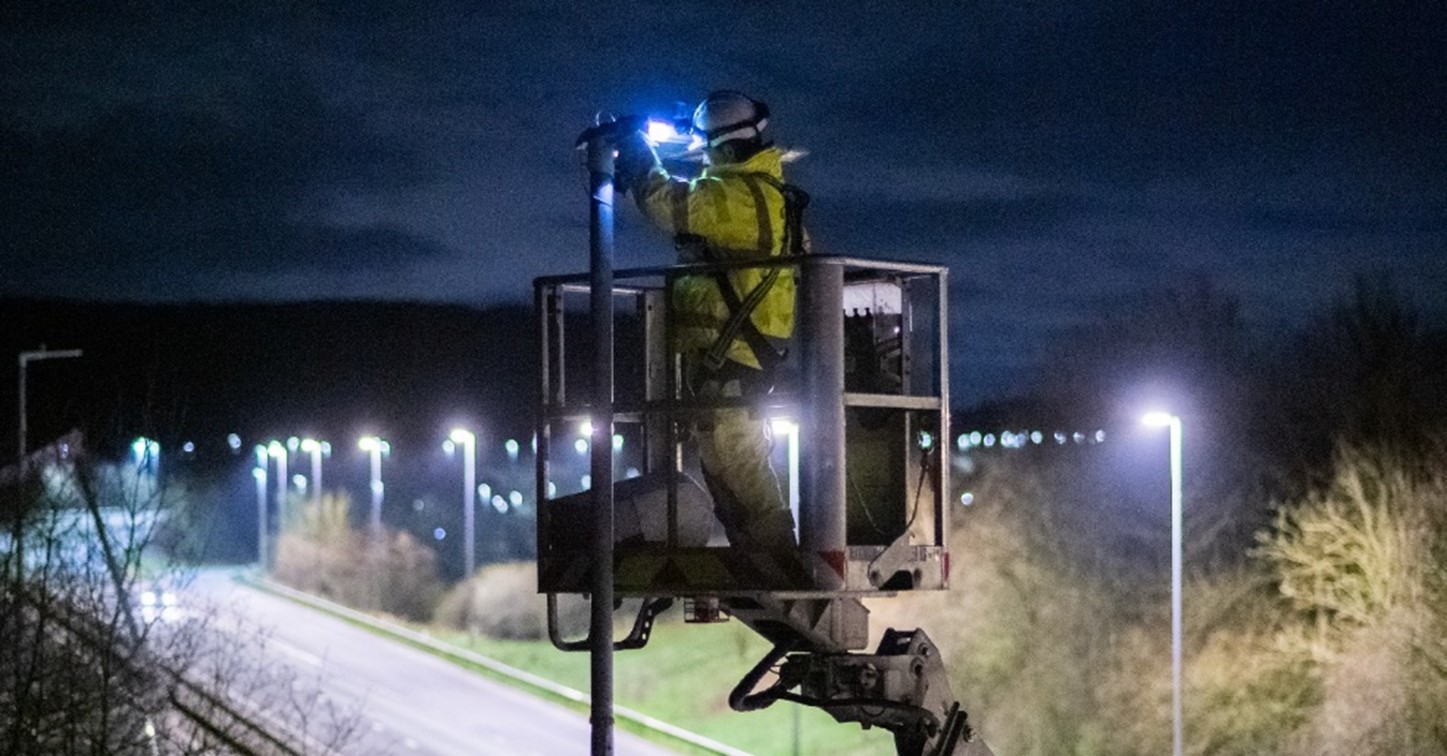
Source: National Highways, worker installing an LED bulb
KPI: noise
4.16 National Highways mitigated noise for 985 households between April 2022 and March 2023. This is fewer than the company expected in the reporting year. The company has mitigated 4,163 households since the start of RP2, it was expecting to have mitigated 5,000 households by March 2023. This is 56% of its target of 7,500 by the end of the road period. It will need to deliver a further 3,337 mitigations in the final two years of RP2 to meet its target.
4.17 National Highways has identified 2,218 mitigations that it has high confidence it can deliver in the final two years of RP2. This would leave the company requiring a further 1,119 mitigations to meet its target of 7,500. At the end of March 2023, it was progressing an additional 1,953 mitigations towards delivery. This includes a contingency above the RP2 target level.
4.18 National Highways expects to mitigate 829 households in the next reporting year. If the company delivers this, it would have to mitigate 2,508 households in the final year of RP2 to achieve its target. In the first year of RP2 it mitigated 2,111 households. This is the highest number it has achieved in a single year.
4.19 We are challenging National Highways on its programme to accelerate and increase the number of noise mitigations delivered. We continue to hold the company to account for achieving its target through increased engagement and scrutinising detailed delivery figures.
KPI: air quality
4.20 We hold National Highways to account to deliver air quality mitigation on links identified by government. Our work sits within a broader framework, with other bodies (Department for Transport (DfT), Department for the Environment, Food and Rural Affairs (Defra) and the Joint Air Quality Unit (JAQU)) also holding the company to account to improve air quality.
4.21 For air quality purposes, 'links' are unique stretches of road between junctions defined by the Defra’s Pollution Climate Mapping (PCM) model. There are 43 links on the SRN that exceed the legal limit for nitrogen dioxide, a pollutant common in vehicle exhausts. National Highways’ air quality performance is reported in its Air Quality on England’s Strategic Road Network: Annual Evaluation Report 2021.
4.22 For 15 of the 43 links, National Highways has considered all potential measures to improve air quality, such as a bus retrofit, speed limits, traffic management measures and pollution barriers. DfT wrote to the company in September 2021 to accept that these links have no viable additional mitigation. The letter set out a monitoring regime that the company must follow for each of these links. DfT also requires the company to publish an annual air quality report.
4.23 National Highways is designing and implementing air quality improvement measures for the remaining 28 links. These measures include reducing speed limits and working with local authorities to encourage the use of electric vehicles on the SRN, through grants and charging hubs. The company has put air quality improvement measures in place on eight of these links. It is working to identify appropriate measures for the remaining 20 links. We are content with the progress that the company has made to deliver these measures and await its next air quality update report, to be published in December 2023.
PIs: being environmentally responsible
4.24 PIs are untargeted metrics. They enable us to scrutinise more aspects of National Highways’ network performance beyond the headline KPI.
Supply chain carbon emissions
4.25 National Highways’ supply chain is critical to the maintenance, renewal, and enhancement of the network. The supply chain emitted 346,910 tonnes of CO2 equivalent in the reporting year. This is higher than the 286,238 tonnes it emitted in the previous reporting year.
4.26 National Highways reports that the increase in emissions is due to additional schemes in construction in the reporting year and an improvement in governance and reporting of carbon emissions of its supply chain.
4.27 Supply chain emissions are affected by the amount of construction delivered on the network. To account for this, National Highways reports on the tonnes of CO2 equivalent per £1 million it spent with its supply chain. For this reporting year, the company reported 134 tonnes of CO2 equivalent per £1 million spent. This is the same as the tonnes of CO2 equivalent per £1 million spend in the previous reporting year.
4.28 In August 2021, National Highways published its Net zero highways plan. The company committed to achieve net zero maintenance and construction emissions by 2040. The company delivered four actions from the plan in the reporting year:
- PAS2080 accreditation of its carbon management system, PAS2080 is a global standard for managing whole-life carbon emissions from infrastructure;
- a carbon construction innovation programme that funds novel solutions to reduce carbon emissions from building and maintaining roads;
- a carbon reduction roadmap across concrete, asphalt and steel that sets out the activities needed across the construction and materials sector to reduce carbon emissions; and
- an improved database of low carbon solutions that holds information on low carbon materials and processes and how they can be used on the network.
Condition of cultural heritage assets
4.29 This PI measures the quality and condition of assets owned by National Highways that are listed on national asset registers, such as Historic England’s listed building data. National Highways reported an improvement in cultural heritage in this reporting year, with a cultural heritage score of 51,626. This is higher than the score of 51,592 in the last reporting year, with works completed on three stone milestones and a historic bridge.
4.30 This metric excludes assets owned by the Historic Railways Estate. This is managed by National Highways on behalf of DfT. We do not report on any aspect of the Historic Railways Estate. This is a matter for DfT.
Water quality
4.31 National Highways improved 6.7km of watercourse in the reporting year, ahead of its own internal forecast of 3.5km. This is due to the difference in size and number of improvements delivered in the year. These improvements are funded by National Highways' environment and wellbeing designated fund.
Litter
4.32 In the reporting year, National Highways surveyed the SRN and reported that 53.6% of the network was rated at Grade A or B according to Defra’s litter code of practice. This was worse than the 60.8% of the network in the previous reporting year being free of litter or predominately free of litter and refuse apart from some small items.
4.33 We have challenged National Highways to use its data on litter on the network to identify and act on litter hotspots, share improved processes across regions and continue to engage with local highways authorities that are responsible for the collection of litter on A-roads. National Highways is currently analysing performance in the reporting year by region and road type. We will work closely with the company in the next reporting year to understand the conclusions of this analysis and challenge it to deliver improvements.
Commitments: being environmentally responsible
4.34 Commitments are priorities that are not suited to metrics, such as developing new metrics, publishing reports on specific performance items or improving reporting for future years.
Investigate, and as appropriate develop, new environmental metrics informed by the natural capital approach
4.35 As reported in our last annual assessment, in September 2021 government agreed to cease further development work on this commitment.
Investigate and assess incorporating into new and existing contracts air quality standards for supply chain vehicles deployed on National Highways work, and associated reporting requirements.
4.36 To progress this commitment, National Highways has committed to zero carbon plant and electric cars and vans by 2030 in its Net Zero Plan, alongside electric or hydrogen heavy vehicles by 2040. The company is also working with its supply chain on securing PAS2080 accreditation for suppliers to improve reporting of carbon data.

